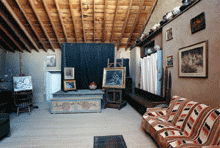 |
|
In 1902, Eanger Irving Couse arrived in Taos, New Mexico where he would become one of the founders of the Taos
Art Colony and the first president of the Taos Society of Artists. Now, more than a century later, E.I. Couse's Taos
home and studio is being acquired by the newly-formed Couse Foundation in order to preserve this Taos landmark for future generations.
|
|
Truly one of the more significant historic structures remaining in Taos today, the home and studio of E.I. Couse stands
as a testament to the beginnings of Taos as an American art colony. The studio has remained essentially intact from the time when Couse
painted the Native American subjects for which he became famous. The house is still complete with its original furnishings, including the
extensive collection of Indian artifacts and the archives of this prominent artist. In this context, visitors to the Couse home may acquire
a sense of the artist's life in these remote and simple surroundings and of the regional elements that had enormous impact on his
artwork.
|

Image: ©2004
The sala of the Couse home
Originally built in 1839
Today it is furnished as it was in 1909 when the
Couses installed wooden floors and benches |
|
E.I. Couse's timeless, iconic paintings of Native Americans are vivid, romantic and mythical. The
philosophy behind them was best articulated in a 1916 letter in which the artist stated his goal was "to remove the misconception
and contempt in which the Indian has been held, and to show that they are human beings worthy of consideration and a place in the sun."
Couse's strong visual portrayals of a proud, noble people engaged in domestic or artistic pursuits, living in spiritual harmony with nature,
soon
began to attract attention in New York and elsewhere in the US and abroad. Eventually, Couse's Indian pictures became well-known to
art connoisseurs and his work appeared regularly in major national and international exhibitions.
|

Image: ©2004
Couse added a large studio shortly after buying
the house in 1909. The studio, as seen here,
remains today as it was during his lifetime |
Throughout his life, Couse focused on contemplative images of the mystical side of native Americans. In this regard, he
did not stress ethnographic accuracy, preferring instead to mix cultural artifacts for aesthetic affect. Couse would convey the significance
of ceremonial activity without recreating an actual situation. By depicting a quintessential Indian image, Couse was not attempting to
document an event nor create a stereotype, rather, he hoped to enlarge the public's understanding of the spiritual nature of Native
Americans through an appreciation of their arts, religion and connectedness to the natural environment.
|
|
Because of his paintings, many of which were reproduced over 23 years for the calendars of the Atchison,
Topeka & Santa Fe Railway, E.I. Couse became known as an image-maker for America. His paintings created a positive and intimate feeling
about Native Americans as a people. This point of view was much needed during the period between the Indian wars of the Nineteenth Century
and the more recent recognition of the civil rights of all people.
|
|
In 1915, Couse and five other artists, all of whom were devoting a major part of their time to painting in Taos, formed
the exhibition group called the Taos Society of Artists. The six charter members of the Taos Society of Artists were: E.I. Couse, Joseph
H. Sharp, Ernest L. Blumenschein, W. Herbert Dunton, Bert G. Phillips and Oscar E. Berninghaus. Over the
next twelve years the TSA's group exhibitions were circulated nationwide. Each member of the TSA had an individual approach to his
southwestern subject matter and the exhibitions were heralded by critics for offering a truly American school of art.
|

Image: ©2004
The distinctive gateway to the Couse home is a 1913 addition that reflects the popularity of Mission Style architecture of that period |

Image: ©2004
A glimpse into
the Couse technique
from the unfinished
canvas that rests on his easel |
In 2002, the E.I. Couse Historic Home and Studio was designated a National Trust Associate Site. The Couse Foundation's
mission includes stabilizing the historic structures on the Couse property—which include the 1836 Luna family chapel and the studio
of Couse's friend and neighbor, Joseph Henry Sharp—and making them accessible to the public. The Foundation's aim is also
to create an educational arm to promote historic preservation, art history and other appropriate regional studies.
The Couse Home and Studio is located at 146 Kit Carson Road in Taos, New Mexico. Arrangements to visit from May through October
can be made by calling 575-751-0369 or 575-737-0105.
Contributions to the Couse Foundation  are tax-deductible and can be sent to PO Box
1436, Taos, NM 87571 are tax-deductible and can be sent to PO Box
1436, Taos, NM 87571 |
Thanks to Virginia Couse Leavitt , granddaughter of E. I. Couse. Mrs Leavitt is an art historian and the author of Eanger Irving
Couse, Image Maker for America (Albuquerque, 1991).
Originally appeared in
The Collector’s Guide to Santa Fe, Taos and Albuquerque - Volume 17
|
|




